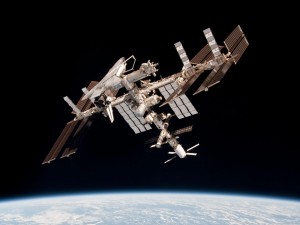An update from Jean-Michel Bois, head of ESA’s mission team at ATV Control Centre, on today’s debris avoidance:
This evening the ATV Control Centre performed the first-ever International Space Station Predetermined Debris Avoidance Manoeuvre (PDAM) using ATV Georges Lemaître to boost the orbiting science complex 0.5 m/s at 17:42 GMT (18:42 CET).
The objective was to avoid an object – 34881 (COSMOS 2251 debris) – set to cross the Space Station’s orbit at 20:13 GMT (21:13 CET). The slight change in the Station’s orbit due to the undocking of the Progress 51P this morning was not enough to avoid the debris.
The PDAM time computation did not put the Space Station in a risky situation with respect to other debris (in particular, object 31289 from FENGYUN 1C, that is passing close but that was not critical in the Station’s initial orbit).
A PDAM procedure was initiated by the Station’s international community in 2012 in response to a late detection of debris – just 6 hours before conjunction!
A PDAM activates a predefined manoeuvre with a unique boost value. This ‘coarse’ manoeuvre is enough to avoid a specific debris object and avoids the long computations necessary to define a tuned trajectory and boost value. The previous PDAM used the Russian Progress cargo vessel thrusters, but since ATV-4, ATV-CC can do the procedure as well.
This manoeuvre demonstrates again the reliability of ATV and the skill of the joint ESA/CNES ATV operations teams. ATVs have delivered all services they were designed for over the course of their five missions.


 Automated Transfer Vehicle page
Automated Transfer Vehicle page ATV blog archive
ATV blog archive
Discussion: 3 comments
Does the PDAM also account for any debris that may intersect the new trajectory? Isn’t it possible for the PDAM to set the ISS into a trajectory with new possible debris intersections?
Thank you.
ATV-CC replies:
You are right. A drawback of this strategy is that it could put the Station on a new trajectory with another risk of conjunction. This risk is evaluated before the manoeuvre. That was the case yesterday with another piece of debris passing close to the Station, but further away. The computations showed that by changing the trajectory we did not create a new risk.
The amount of debris in the Space Station trajectory and the probability is low !
Keep in mind that before this procedure, the only solution for an urgent debris alert was to ask the crew to go into the two Soyuz spacecraft and be ready to evacuate while crossing fingers ….
Actually, this PDAM procedure can also be performed by a Progress spacecraft located on the “side” of the Station (DC1 port), and not in the same axis as ATV. Boosting the Station from this position creates a different trajectory. An evolution of the onboard software allows the choice among three determined boost values.
Note also that the Debris Avoidance Manoeuvrer “disturbs” the Station’s trajectory in regards to the ongoing visiting vehicle approaches. Yesterday we needed to verify that the docking of Progress 57P on 29 October was not impacted by this manoeuvre.
Fortunately, space debris is well tracked in general, and a classical Debris Avoidance Manoeuvre procedure, starting 24 hours in advance, with a tuned delta V, remains the baseline. This PDAM procedure is exceptional.
Hi John,
the size of the avoidance manoeuvre is programmed to allow a safe clearance between the ISS and the debris.
Before the manoeuvre is performed, mission analysts verify that the “modified” orbit does not end up in increasing the collision risk and/or decreasing the separation with other debris.
Once that the information about other potentially dangerous debris is achieved, the actual manoeuvre is perfomed on board.